 |
 |
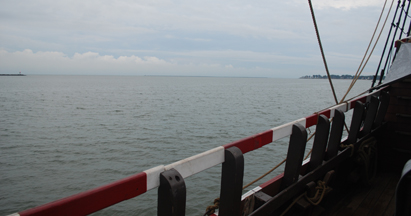
0700 hours
Starting Position: Anchored at Duck Island Roads.
Latitude: 41˚ 15.8' N
Longitude: 072˚ 28.9' W
Day Three of the 2010 Fresh River Voyage of Discovery.
After a slightly wet night, we rise this morning to see overcast skies and calm seas.
|
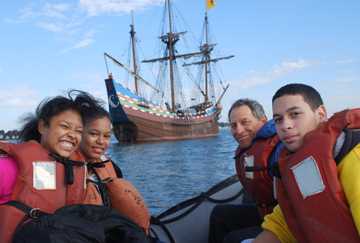
0930 hours
We will be leaving Long Island Sound today, but before our layover ends, we still have time for a few more Zodiac expeditions.
|
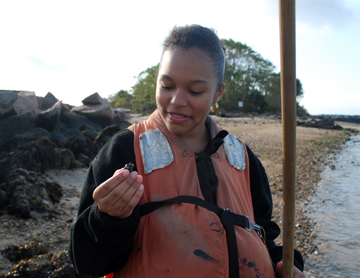
The first expedition of the morning heads out to the nearby islands to explore the marine environment.
|
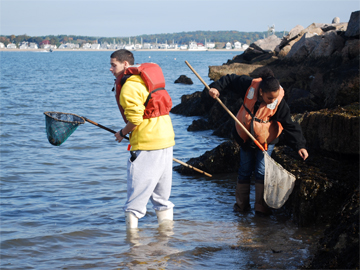
We've timed our visit for low tide, when it's easiest to find coastal creatures hiding under the rocks and soil.
|
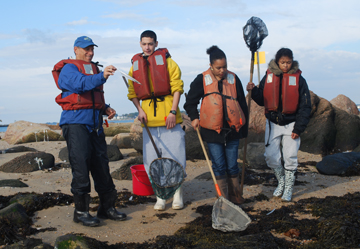
1030 hours
After an hour of exploring, the Zodiac team gathers up their gear to return to the ship. Our science officer, Mr. Garfinkel, is eager to point out the flora and fauna we've collected. Visit the Wildlife page to see come of our collection!
|
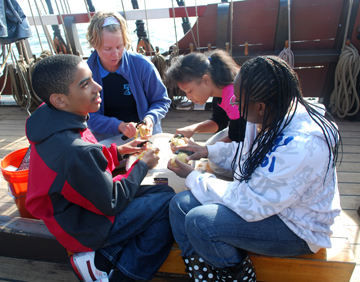
1045 hours
Back on the ship, Ms. Waiboer, Kelsey, Monet, and Teara are already hard at work on tonight's dinner. You need to peel a lot of potatoes to feed 24 hungry people!
|
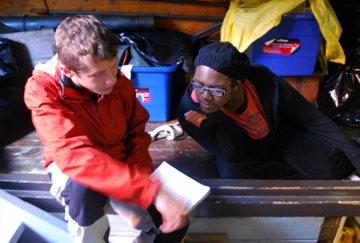
Down on the orlop deck, Erica is helping Karl study his Crew Rating Log.
|
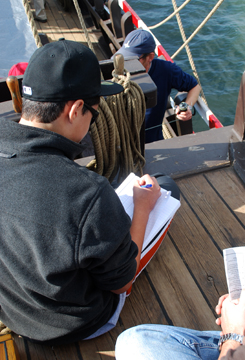
1100 hours
After spending yesterday orienting the students to the experiments and equipment we use on board, today marks our shift into active data collection for the students' presentation projects.
|
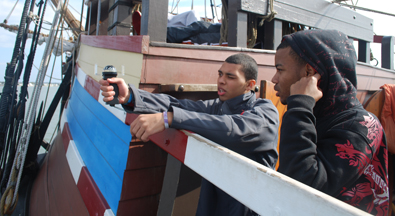
1130 hours
The Statistical Analysis team of Claudio, Daniel, Teara, and Wilberto is busy gathering up everyone in the crew to sight a distant radio tower on shore, an experiment they'll repeat several more times before all is said and done.
|
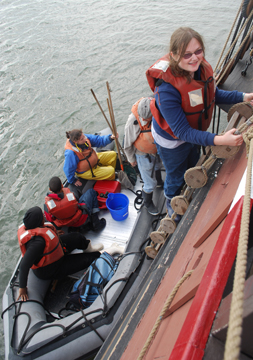
Meanwhile, Mr. Woodworth has collected another batch of sailors for the next Zodiac expedition.
|
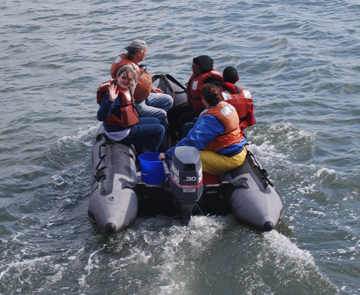
They too will explore the nearby wetlands, getting hands-on with the marine ecology of Long Island Sound.
When they return from this trip, Mr. Woodworth claims that they found fifty (small) crabs resting under a single rock. They only bring a few back to the Half Moon, however, since our aquarium is already well stocked.
|
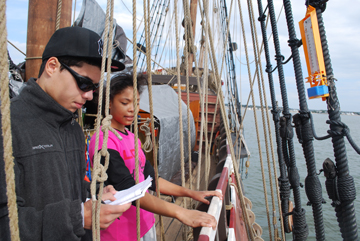
1145 hours
As the morning ends, we find Daniel and Monet checking the relative humidity for the Deck Log.
|
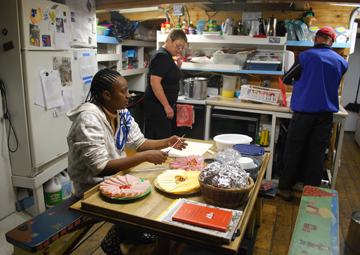
1200 hours
Belowdecks, Teara is wrapping up her hour in the galley. It looks like lunch is nearly ready!
|
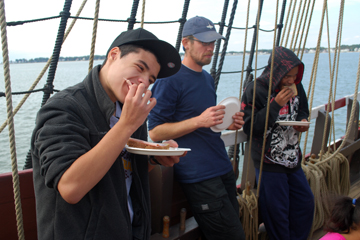
1230 hours
We guessed right! The crew gets to make their own sandwiches today, alongside a bowl of hot soup.
|
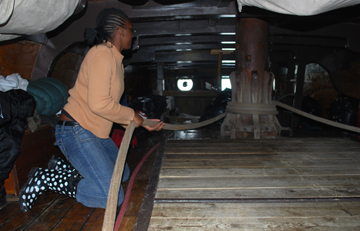
1330 hours
The tide has turned, so it's time to move on! We begin the process of weighing anchor for what we expect to be the final time on this voyage, but that's a tale for another day...
At the moment, Teara is stationed on the starboard orlop deck. Her task is to help guide the inbound anchor rode around the lower capstan, preventing overrides: tangles caused by slack lines.
|
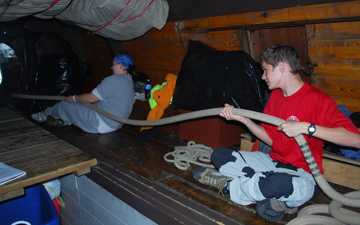
Solange and Karl are stationed on the port side of the orlop deck. After the anchor rode passes around the lower capstan, they help haul the anchor rode back up to the ship's bow...
|
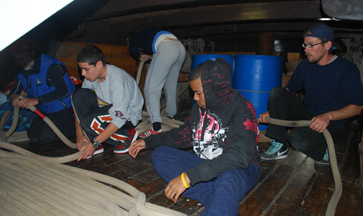
...where our "fakers" are hard at work. (In nautical terms, to fake a line is to neatly fold it.) Ms. Waiboer tends the bits; her task is to be ready to make fast the anchor rode at a moment's notice as a failsafe measure.
|
Mouse over to weigh anchor!
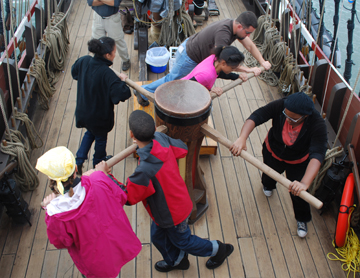 |
With the rode run out and ready below, the action moves back up to the weather deck. Up on the capstan!
|
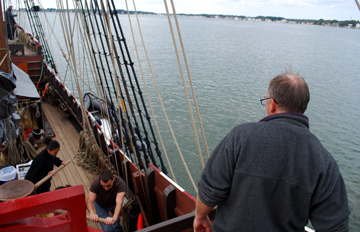
Captain Reynolds uses the ship's engine to lighten the load on our capstan crew. In Hudson's day, sailors attempting to fight wind and waves to weigh anchor might be forced to labor against their capstan bars for hours — or even days!
|
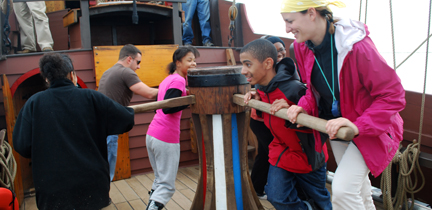
In our case, however, the load may be heavy but it doesn't last long. Our capable capstaneers soon haul the anchor up to the water line.
|
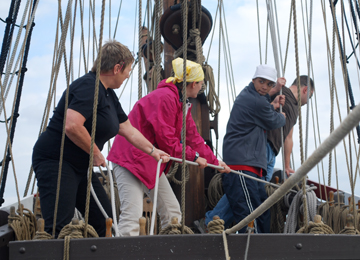
1345 hours
Ms. Bisson and Ms. Bruijn next move up to the fore deck to lend Mr. Roy and lookout Wilberto some much-needed muscle.
They haul the anchor up to the fore channel, where Mr. Woodworth once again secures it. We're on our way!
|
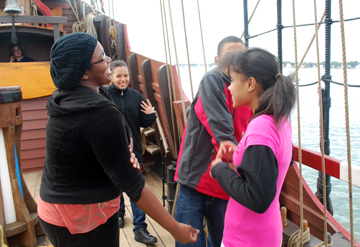
Their job done, the capstan team discusses the upper-body workout they've just received.
|
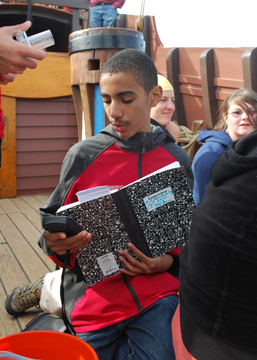
1430 hours
With the ship now eastbound toward the Connecticut River, we find Kelsey busy updating the Deck Log.
|
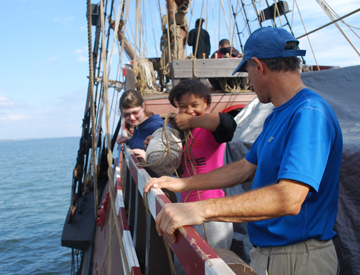
1445 hours
Time to throw a new experiment into the mix! Mr. Garfinkel starts showing groups of students how to collect water samples for our salinity tests.
|
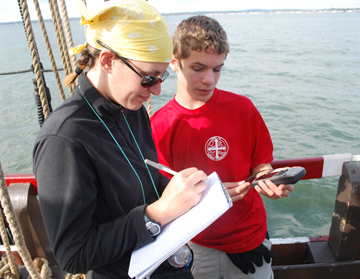
If the Connecticut River is true to its old Dutch name (the Fresh River), we should see salinity levels drop to 0 PPT (parts per thousand) almost as soon as we enter the mouth of the river.
|
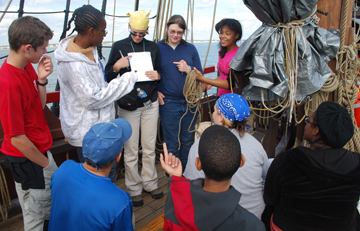
1500 hours
Once the first team of students has mastered salinity collections, Ms. Bisson has them teach their peers how to follow suit.
|
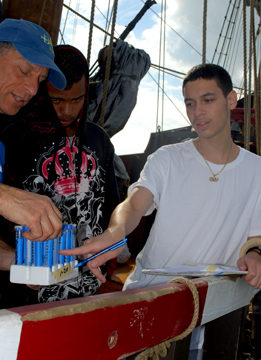
We'll continue collecting water samples at regular intervals (roughly every half-degree of latitude) until we reach our destination tonight.
|
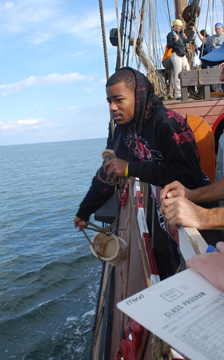
Tomorrow, we'll analyze the samples and see our results.
|
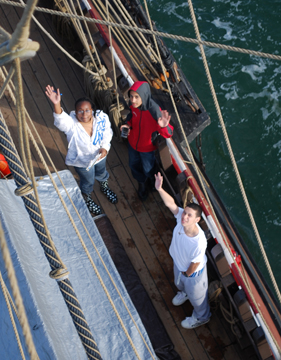
1530 hours
As we approach the mouth of the Connecticut River, we come upon an interesting sight. Other than the students, that is...
|
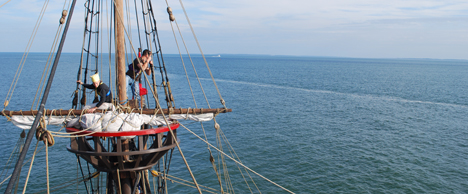
That line in the water is a tidal bore, formed where two strong currents abut each other. In this case, it's the flow of the Connecticut River pouring out into the prevailing current of Long Island Sound.
|
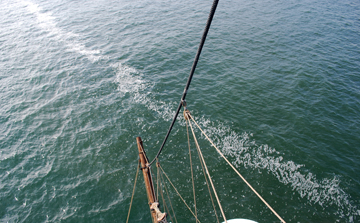
The briny froth marks the exact spot where these two currents meet, almost as though a line had been drawn across the water.
|
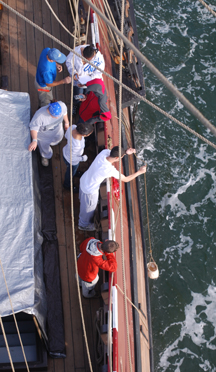
The salinity team jumps into place to collect samples just before and just after we cross the tidal bore. In theory, we could see a marked difference in salinity on either side. In fact, in the right light, we've even seen the water take different colors to either side (blue water coming from the river alongside the green seawater of the sound).
|
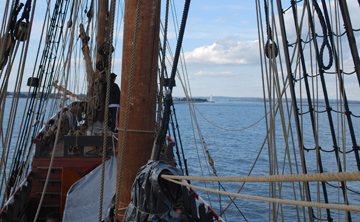
1600 hours
We're turning north to make our approach into the mouth of the Connecticut.
|
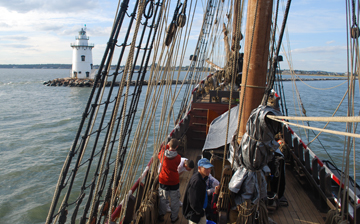
1615 hours
As we pass the lighthouses marking the entrance to the river, we bid Long Island Sound farewell. (Of course, some of the senior crew will be back here again in November.)
|
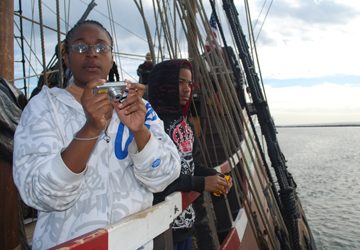
The students have time to admire the scenery as we make our approach.
|
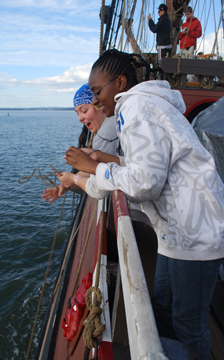
1630 hours
Not too much time, though! Those salinity samples won't wait!
|
|
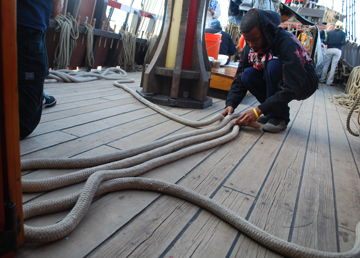
Our destination is just ahead — nearly within sight — so we prepare our docklines. Here, Claudio is faking Line Three so it can run out freely.
|
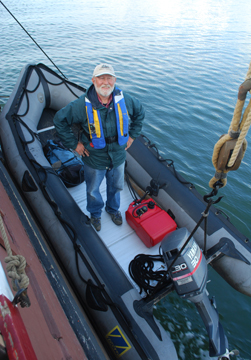
Mr. Hansen is dispatched to the Zodiac. First, he'll ferry Mr. Hensel in to the dock to handle our lines, then he'll use the Zodiac to help guide the ship, just as a tugboat helps guide larger vessels.
|
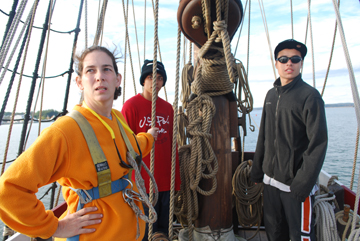
Ms. Reilly and Wilberto join lookout Daniel on the fore deck, reporting oncoming water traffic and the state of our Line One dockline.
|
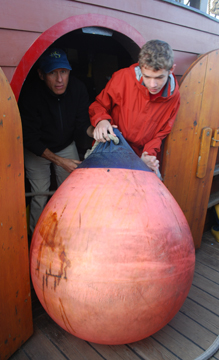
Finally, Karl and Mr. Garfinkel help prepare our fenders for deployment. Just like the fender on a car, our fenders help protect the ship from damage while at a dock.
We're ready for the dock!
|
Mouse over to keep up with the ship!
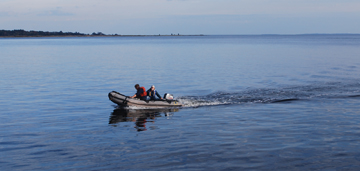 |
1645 hours
But as it turns out, we have some time to kill. A locomotive drawbridge crosses the mouth of the Connecticut River, and we've arrived at rush hour. Both we and the Zodiac slow our approach to the bridge, waiting for the all clear.
|
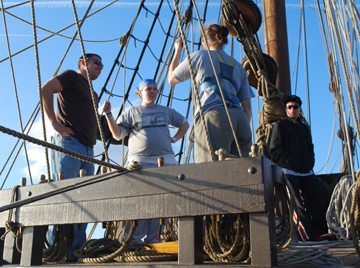
1700 hours
While we have a moment, Ms. Reilly refreshes Daniel, Solange, and Mr. Roy on some sail handling techniques. |
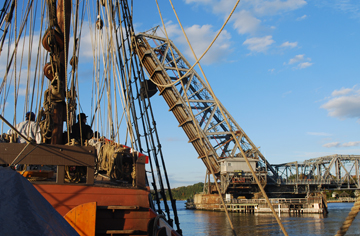
1730 hours
The bridge is open! We grab our chance to enter the river.
|
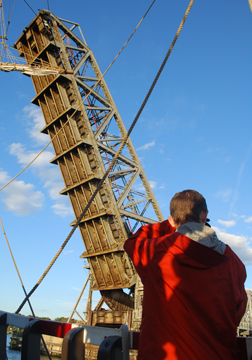 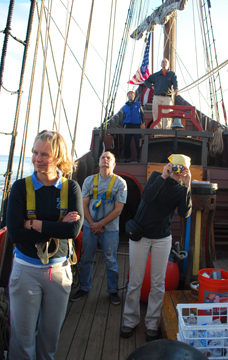
Thanks to our 80-foot masts, it's a bit of a tight fit. Everyone gathers around to watch the towering bridge slide past us.
|
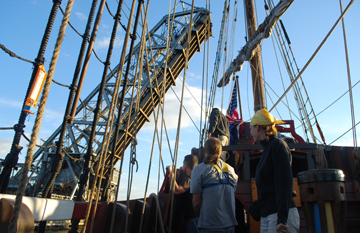
And we're clear!
|
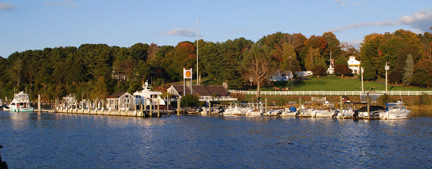
Our destination lies just ahead! The line handlers leap into place, and the ship is soon docked.
|
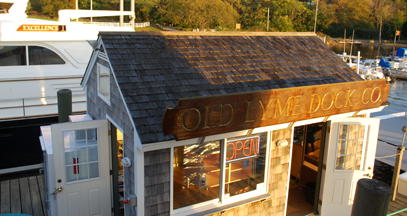
1800 hours
Ending Position: Docked at Old Lyme Dock Co., Old Lyme, CT.
Latitude: 41˚ 18.9' N
Longitude: 072˚ 20.7' W
We will be spending the night at the Old Lyme Dock Company, a refueling dock that has often generously donated docking space to us during our annual voyage upriver.
|
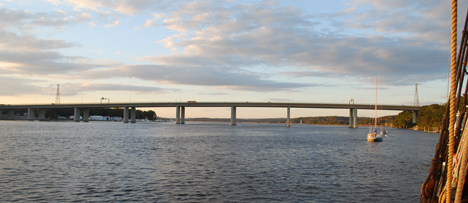
Just beyond Old Lyme stands the I-95 bridge, our next navigational challenge — but more on that in a moment.
|
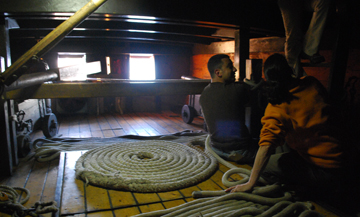
We double up on docklines One and Four to fend off the river's swift current. We soon have the ship secured for the night.
|
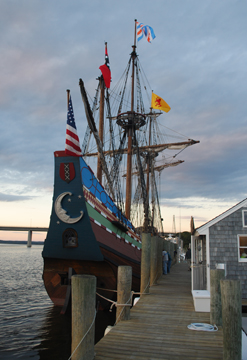
This is the first time the Half Moon has visited the Fresh River during the autumn; our voyages usually fall in the middle of summer. While preparing for this voyage, we expected to face slow currents and low waterlines, but as it turns out the opposite is true!
Why? Connecticut was deluged by a major rainfall a few weeks ago, and the river's vast watershed is still funneling that water out into the Sound even now.
|
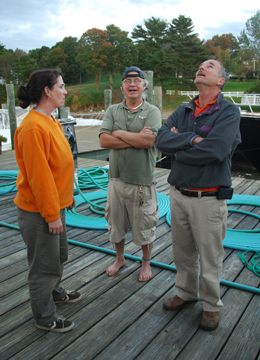
1815 hours
Captain Reynolds and Ms. Reilly step onto the dock to greet Jay Pocius, a longtime Half Moon crew member and administrator of the New Netherland Museum's database. A local resident, he's come to pick up the captain for a quick trip upriver: a scouting mission to sound the dock at the Goodspeed Opera House. We need to make sure that it can accomodate us before we arrive tomorrow.
The Captain soon returns, and the word is good: the water is just deep enough to house the Half Moon.
|
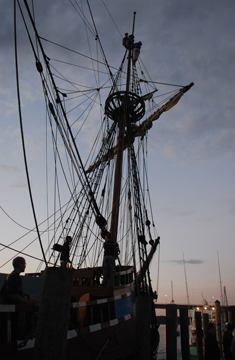
1830 hours
In the meantime, Ms. Reilly and Ms. Waiboer (you may notice them as tiny silhouettes at the very, very top of the mast) are dealing with a different sort of vertically aligned problem.
From our previous voyages up the Connecticut, we know that the Half Moon's masts only clear the I-95 bridge by a few feet, and with the river's swollen currents, even that isn't certain. The decision has been made to lower the flagstaffs atop the fore and main masts, which buys us an extra fathom of headroom.
When our bosun and rigger return to deck, it's time for meatloaf, green beans, and mashed potatoes (lots of mashed potatoes) for dinner!
|
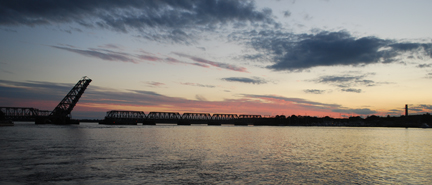
As night descends, we check our salinity samples and discover that here at the dock, the water is already completely fresh.
Since we're staying at a known dock and have already observed high and low tide, we have no need to maintain a watch tonight. The crew receives the rare treat of sleeping straight through the night.
Next Time: A Night at the Opera House!
|
|
|
|
|



